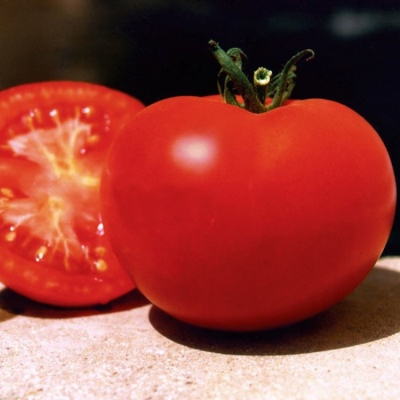
- Authors: HM. CLAUSE S.A., France
- Year of approval: 2007
- Name synonyms: BAGHERA
- Category: hybrid
- Growth type: determinant
- Appointment: universal
- Ripening period: mid-season
- Ripening time, days: 65
- Growing conditions: for open ground
- Marketability: Yes
Bagheera is a relatively new tomato variety that was approved for use 14 years ago. Its authors are French breeders. Despite its foreign origin, the Bagheera variety has perfectly adapted to Russian conditions.
Description of the variety
This is a determinant type of plant with a bush height of up to 80 cm. The bush is short, compact, but has a high vigor. The variety is characterized by strong foliage, dark green leaves of medium size.
The main qualities of the fruit
When unripe, the peel of the fruit is light green, ripe tomatoes are colored red. Their size is large, flat-round shape, weight - 180-250 g. These tomatoes have excellent transportability and keeping quality for at least 30 days.
Taste characteristics
According to most consumers, Bagheera tomatoes taste great. The red pulp is fleshy, dense, contains 2.1% sugar. The peel is thick, which provides the tomatoes with long shelf life and excellent presentation.
This is a versatile variety that is perfect both for fresh consumption and for harvesting, however the first option is preferable, since the dense skin can change the taste properties of salted or pickled tomatoes.
Ripening and fruiting
Bagheera belongs to the mid-season varieties. Ripening period is 65 days, long-term fruiting.
Yield
This is a productive variety, capable of producing 298-692 centners per hectare of fruit.
The timing of planting seedlings and planting in the ground
Growing seedlings consists of the following stages.
These seeds do not need additional processing. The planting material purchased in the store has already passed all stages of preparation and can be sown immediately after purchase.
The recommended seedling substrate should contain equal proportions of peat and humus.
Sowing depth - no more than 2 cm. After planting, the soil should be sprinkled with warm water.
As soon as the first leaves hatch at young seedlings, liquid mineral fertilizers should be applied every two weeks.
For good future adaptation, you can periodically harden the shoots. First, you can leave them outside for an hour, and then for the whole day.
Transplanting into open ground is carried out at the end of May or at the beginning of June. In the first days after transplanting, cover the plants with foil. Treat the ridge with a solution of potassium permanganate as a prophylaxis.

Growing tomato seedlings is an extremely important process, because it largely depends on whether the gardener will be able to harvest at all. All aspects must be taken into account, from seedbed preparation to planting in the ground.
Landing scheme
When sowing seeds for seedlings, plant 6 seeds per 1 m2. When transplanting to a summer cottage, the density of seedlings should be 20-22 thousand per hectare.

Growing and care
The Bagheera variety is highly resistant to drought, and also perfectly tolerates cold. These tomatoes are recommended to be grown in the North Caucasus region. Observe the following guidelines when leaving.
Watering
The most preferable type of irrigation is drip. The culture responds well to warm, settled water. It is very important to control this process, not to overmoisten the earth and not to allow it to dry out. Seedlings are watered with 1-1.5 liters of water at a time; during flowering, 20-25 liters per 1 m2 will be required; at the time of fruit ovary - 35-40 liters per 1 m2; when ripe - 60-70 liters per 1 m2.
When harvesting, watering should be stopped, as soil moisture can lead to cracking of the fruit. When irrigating, try not to get water on the green mass.
Top dressing
The first fertilizers are applied two weeks after transplanting to the summer cottage. A mixture of saltpeter, superphosphate and potassium salt can serve as the first additional additive. After 2.5-3 weeks, phosphorus and potassium compositions will be relevant.
Bagheera tomatoes have high immunity to verticillary and fusarium wilt, very rarely they are affected by insects, so additional treatments can be omitted. It is enough to follow all the rules of agricultural technology.




A plant needs different micronutrients at each stage of growth. All fertilizers can be divided into two groups: mineral and organic. Folk remedies are often used: iodine, yeast, bird droppings, eggshells.
It is important to observe the rate and period of feeding. This also applies to folk remedies and organic fertilizers.



























































































